*NURSING > QUESTIONS and ANSWERS > {ANSWERED} ATI RN 231 231 Quiz 2_Cloned_Assessment 1/ Questions and Answers with Rationales/Download (All)
{ANSWERED} ATI RN 231 231 Quiz 2_Cloned_Assessment 1/ Questions and Answers with Rationales/Download To Score A
Document Content and Description Below
1. A client with increased right ventricular preload has a central venous pressure (CVP) monitoring catheter in place. The nurse should expect which of the following (CVP) measurements? A. 1 mm Hg R... ationale: A CVP below 2 mm Hg indicates reduced right ventricular preload, typically from hypovolemia. B. 3 mm Hg Rationale: This CVP is within the expected reference range. C. 5 mm Hg Rationale: This CVP is within the expected reference range. D. 7 mm Hg Rationale: A CVP above 6 mm Hg indicates an increased right ventricular preload, typically from hypervolemia. 2. A nurse is assessing a client who is postoperative and has anemia due to excess blood loss during surgery. The nurse should expect which of the following findings? A. Fatigue Rationale: Fatigue is an expected finding with a client who has anemia due to surgical blood loss. This is because of the decreased ability of the body to carry oxygen to vital tissues and organs. B. Respiratory depression Rationale: Tachypnea is more likely than respiratory depression in a client who has anemia due to blood loss. C. Bradycardia Rationale: Tachycardia is more likely than bradycardia in a client who has anemia due to blood loss. D. Muscle cramps Rationale: Anemia from blood loss is unlikely to cause muscle cramps, although it can cause other painful manifestations, such as angina. 3. A nurse assessing a client determines that he is in the compensatory stage of shock. Which of the following findings support this conclusion? A. Confusion Rationale: Confusion characterizes the compensatory stage of shock, as do decreased urinary output, cold and clammy skin, and respiratory alkalosis. B. Lethargy Rationale: Lethargy characterizes the progressive stage of shock. C. Unconsciousness Rationale: Unconsciousness characterizes the irreversible stage of shock. D. Petechiae Rationale: Petechiae characterize the progressive stage of shock. 4. A nurse on a critical care unit is caring for a client who has shallow and rapid respirations, paradoxical pulse, CVP 4 cm H2O, BP 90/50 mm Hg, skin cold and pale, and urinary output 55 mL over the last 2 hr. From these findings, the nurse concludes that he may be developing which of the following? A. Hypovolemic shock Rationale: The client’s signs and symptoms are all indicative of hypovolemic shock. The nurse should conclude that the client may be developing this outcome. B. Cardiac tamponade Rationale: While some of the findings indicate cardiac tamponade, the urinary output and CVP distinguish between hypovolemic shock and cardiac tamponade. C. Sepsis Rationale: While some of the findings might indicate atelectasis, the combination of the client’s signs and symptoms are not indicative of this outcome. D. Atelectasis Rationale: While some of the findings might indicate atelectasis, the combination of the client’s signs and symptoms are not indicative of this outcome. 5. A nurse is caring for a client who has hypovolemic shock. Which of the following blood products does the nurse anticipate administering to this client? A. Cryoprecipitates Rationale: Cryoprecipitates are administered to clients with hemophilia or von Willebrand’s factor. B. Platelets Rationale: Platelets are administered to clients who have thrombocytopenia. C. Fresh frozen plasma (FFP) Rationale: Fresh frozen plasma is not adequate to replace blood loss which occurs in hypovolemic shock. D. Packed red blood cells (PRBC) Rationale: PRBC is given to restore blood volume and replace hematocrit and hemoglobin levels in a client who has hypovolemic shock. 6. Which of the following is the most common reason for the PAOP and CVP to increase? A. left and RV failure. B. excess blood volume. C. RV failure. D. pulmonary hypertension 7. Assuming that vascular volume is adequate, which medication would have the strongest effect on raising the blood pressure in a hypotensive patient? A. norepinephrine (Levophed). B. dobutamine (Dobutrex). C. epinephrine (Adrenalin). D. esmolol (Brevibloc). 8. When initiating a dopamine IV infusion for hypotensive client, which intervention should the nurse include in the client's plan of care? A. Assess bilateral breath sounds. B. Perform neuro assessment every 12 hours. C. Monitor urine output every hour. D. Observe pulmonary capillary wedge pressure. 9. Nursing care for a 58-year-old female client with postoperative complications includes CVP monitoring. What is the most important consideration in measuring CVP? A. Blood samples should not be drawn through the subclavian catheter if it is being used for CVP. B. Having the client cough during CVP measurement will allow for more accurate readings. C. The zero point on the manometer must be leveled with the right atrium. D. The client must be lying flat in bed during the measurement procedure. 10. A septic patient with hypotension is being treated with dopamine hydrochloride. The nurse asks a colleage to double-check the dosage that the client is receiving. There are 400 mg of dopamine hydrochloride in 250 ml D5W, the infusion pump is running at 23 ml/hr, and the client weighs 79.5 kg. How many micrograms per kilogram per minute (mcg/kg/min) is the client receiving? Do not round off your answer. 7.71 mkg/kg/min 11. Reduction of myocardial oxygen consumption is best achieved through which of the following changes? A. reducing afterload Rationale: Decreaseing the amount of stretch in cardiac muscle just before contraction decreases the oxygen concumption significantly. B. reducing preload C. increasing contractility D. increasing preload 12.A A client has a pulmonary artery wedge pressure (PAWP) reading of 15 mm Hg. Which of the following conditions might the nurse expect this finding to indicate? A. Fluid volume deficit Rationale: The PAWP is a mean pressure that is expected to range between 4 and 12 mm Hg. A reading of 15 mm Hg is elevated. Elevated PAWP measurements may indicate hypervolemia (fluid volume excess), left ventricular failure, mitral regurgitation, or an intracardiac shunt. B. Right ventricular failure Rationale: Increased right atrium (RA) pressure can occur with right ventricular failure. Low RA pressure usually indicates hypovolemia. C. Mitral regurgitation Rationale: Expected PAWP readings are between 4 and 12 mm Hg. Elevated PAWP measurements may indicate hypervolemia, left ventricular failure, mitral regurgitation, or intracardiac shunt. D. Afterload reduction Rationale: A decreased PAWP is seen with hypovolemia or afterload reduction. This client’s PAWP reading was elevated at 15 mm Hg. 13.A A nurse is caring for a client who is at risk for shock. Which of the following findings is the earliest indicator that this complication is developing? A. Hypotension Rationale: Hypotension is an early sign of shock, but it is not the earliest indicator. B. Decreased urine output Rationale: Decreased urine output is a sign of shock, but it is not the earliest indicator. C. Narrowing pulse pressure Rationale: Narrowing pulse pressure is the earliest indicator of shock. D. Decreased level of consciousness Rationale: Decreased level of consciousness is a sign of shock, but it is not the earliest indicator. 14.A A nurses is assessing for the development of disseminated intravascular coagulation (DIC) in a client who has septic shock. Which of the following nursing statements indicates an understanding of the condition? A. “DIC is controllable with lifelong heparin usage.” Rationale: The nurse should understand DIC is not controlled with lifelong heparin usage, but Heparin is administered to minimize the formation of microthrombi to improve tissue profusion. B. “DIC is characterized by an elevated platelet count.” Rationale: The nurse should understand DIC causes bleeding due to a decreased platelet count, not elevated platelet count. C. “DIC is caused by abnormal coagulation involving fibrinogen.” Rationale: The nurse should understand DIC is caused by an abnormal coagulation involving fibrinogen formation and platelet counts. D. “DIC is a genetic disorder involving vitamin K deficiency.” Rationale: The nurse should understand DIC is not a genetic disorder involving vitamin K deficiency. Vitamin K prolongs bleeding time. 15.A A client experiences anaphylactic shock in response to the administration of penicillin. Which of the following medications should the nurse administer first? A. Dobutamine Rationale: Dobutamine does not reverse the most severe manifestations of anaphylactic shock; therefore, should not be the treatment of choice. B. Corticosteroids Rationale: C. Furosemide Methylprednisolone does not reverse the most severe manifestations of anaphylactic shock; therefore, should not be the treatment of choice. Rationale: Furosemide may improve renal profusion, but does not reverse the most severe manifestations of anaphylactic shock; therefore, should not be the treatment of choice. D. Epinephrine Rationale: Epinephrine does reverse the most severe manifestations of anaphylactic shock; therefore, should be the treatment of choice. 16.A A nurse is caring for a client who returns to the nursing unit from the recovery room after a sigmoid colon resection for adenocarcinoma. The client had an episode of intraoperative bleeding. Which finding indicates to the nurse that the client may be developing hypovolemic shock? A. Decrease in the respiratory rate from 20 to 16 breaths per minute. Rationale: This change in respiratory rate is not significant as both values are within the expected range. B. Decrease in the urinary output from 50 mL to 30 mL per hour. Rationale: This change in urinary output is not significant as both values are within the expected range. C. Increase in the temperature from 37.5° C (99.5° F) to 38.6° C (101.5° F). Rationale: Hyperthermia is not an initial sign of hypovolemic shock. One of the classic signs of shock is cool, moist skin. Hyperthermia is seen in septic shock. D. Increase in the heart rate from 88 to 110 beats per minute. Rationale: Hypovolemic shock is a condition where the heart is unable to supply enough blood to the body because of blood loss or inadequate blood volume. This change in heart rate may indicate hypovolemia as the first value is within the expected range, but the second value is very elevated for an adult client. 17.A A nurse is caring for an adult client who is in the compensatory stage of shock. Which of the following is an expected finding? A. Mottled skin Rationale: Cold, diaphoretic skin is present in the compensatory stage of shock. B. Blood pressure 115/68 mmHg Rationale: The client’s blood pressure remains within normal limits during the compensatory stage of shock. C. Heart rate 160/min Rationale: A heart rate of 100-150/min is present in the compensatory stage of shock. D. Metabolic acidosis Rationale: Respiratory alkalosis is present in the compensatory stage of shock. 18.A A nurse is caring for a client who has hypovolemic shock. Which of the following is an expected finding? A. Hypertension Rationale: Hypotension is a sign of hypovolemic shock. B. Purpura Rationale: Pallor is a sign of hypovolemic shock. C. Oliguria Rationale: Oliguria is present in hypovolemic shock as a result of decreased blood flow to the kidneys. D. Bradypnea Rationale: Tachypnea is a sign of hypovolemic shock. 19. A nurse is assessing a client who has disseminated intravascular coagulation (DIC). Which of the following should the nurse expect in the findings? A. Excessive thrombosis and bleeding. Rationale: The nurse should expect to find excessive thrombosis and bleeding of mucous membranes because the anticoagulant pathways are impaired. B. Progressive increase in platelet production. Rationale: The nurse should expect to find a decrease, not increase, in platelet count because of the increase in platelet consumption involved in the impaired anticoagulant pathways. C. Immediate sodium and fluid retention. Rationale: The nurse should not find changes in the sodium and fluid retention with this condition. D. Increased clotting factors. Rationale: The nurse should expect a decrease, not an increase, in the clotting factors because the anticoagulant pathways are impaired. 20.A A nurse in the emergency department is caring for a client who has anaphylaxis following a bee sting. Which of the following is the priority intervention? A. Observe for periorbital edema. Rationale: The nurse should observe for periorbital edema; however, this is not the priority intervention when taking the airway, breathing, circulation (ABC) approach to client care. B. Evaluate for local edema. Rationale: The nurse should evaluate for local edema; however, this is not the priority intervention when taking the airway, breathing, circulation (ABC) approach to client care. C. Auscultate for wheezing. Rationale: The nurse should first auscultate for wheezing when taking the airway, breathing, circulation (ABC) approach to client care. D. Monitor for hypotension. Rationale: The nurse should monitor for hypotension; however, this is not the priority intervention when taking the airway, breathing, circulation (ABC) approach to client care. 21.A A nurse is teaching a client, who has acute renal failure (ARF), about the oliguric phase. Which of the following is appropriate to include in the teaching? A. Normal renal tubular function is reestablished during this phase. Rationale: This is associated with the recovery phase of ARF. B. BUN and serum creatinine levels begin to decrease. Rationale: This is associated with the diuresis phase of ARF. C. Fluid output is less than 400 ml per 24 hours. Rationale: Inadequate urinary output is associated with the oliguric phase of ARF. D. Fluid output is greater than 1000 ml per 24 hours. Rationale: Increased urinary output is associated with the diuresis phase of ARF. 22. A client who has left ventricular failure and a high pulmonary capillary wedge pressure (PCWP) is receiving dopamine IV to improve ventricular function. Which of the following changes indicates to the nurse that the medication is having a therapeutic effect? A. Systolic blood pressure increases. Rationale: When dopamine has a therapeutic effect, it causes vasoconstriction peripherally and increases systolic blood pressure. B. QRS width increases. Rationale: A wide QRS complex indicates a dysrhythmia that is an adverse effect, not a therapeutic effect, of dopamine. C. Apical heart rate increases. Rationale: Tachycardia is an adverse effect, not a therapeutic effect, of dopamine. D. PCWP increases. Rationale: Dopamine should lower the PCWP. 23.A A triage nurse in an emergency department is caring for a client who has a gunshot wound to the right side of her chest. The nurse notes a thick dressing on the chest and a sucking noise coming from the wound. The client has a blood pressure of 100/60 mm Hg, a weak pulse rate of 118/min, and a respiratory rate of 40/min. Which of the following actions should the nurse take initially? A. Raise the foot of the bed to a 90° angle. Rationale: Trendelenburg position increases pressure on the heart and lungs and is contraindicated for a client who has an open chest wound. B. Remove the dressing to inspect the wound. Rationale: A dressing should not be removed from a sucking chest wound until immediately prior to chest tube insertion. Removal of the dressing will cause an increase in size of the pneumothorax and increased respiratory difficulty. C. Prepare to insert a central line. Rationale: Although the client may need IV access, a central line is not usually needed in this situation. D. Administer oxygen via nasal cannula. Rationale: The client has an increased respiratory rate and heart rate, indicating that she is having respiratory difficulty. Administering oxygen will increase the oxygen exchange in the lungs and the oxygen available to the tissues. 24. A client is admitted to the emergency room with a respiratory rate of seven per min. Arterial blood gases (ABG) reveal the following values. Which of the following is an appropriate analysis of the ABGs? pH 7.22 PaCO2 68 mm Hg Base excess -2 PaO2 78 mm HG Saturation 80% Bicarbonate 28 mEq/L A. Respiratory acidosis Rationale: The normal pH is 7.35 to 7.45. The pH of 7.22 indicates that this client is acidotic. In this example, the pH is decreased while the PCO2 is elevated. Therefore, the correct interpretation of the results is that the client is in respiratory acidosis. B. Metabolic acidosis Rationale: This is not the correct analysis of the ABGs. C. Metabolic alkalosis Rationale: This is not the correct analysis of the ABGs. D. Respiratory alkalosis Rationale: This is not the correct analysis of the ABGs. 25.A A nurse is caring for four hospitalized clients. Which of the following clients is at greatest risk for fluid volume deficit? A. The client who has been NPO since midnight for endoscopy. Rationale: Most clients with a baseline normal fluid status can tolerate being NPO overnight without risk of fluid volume deficit. B. The client who has congestive heart failure and is on diuretic therapy. Rationale: The client who has congestive heart failure is likely to have fluid volume excess that is being treated with the diuretics. C. The client who has end-stage renal failure and is scheduled for dialysis today. Rationale: The client who has end-stage renal failure is likely to have fluid volume excess that is being treated with the dialysis. D. The client who has just been admitted, has gastroenteritis, and is febrile. Rationale: This client has two risk factors for the development of fluid volume deficit, or dehydration. Gastroenteritis is characterized by diarrhea and may also be associated with vomiting, so it can be a significant source of fluid loss. The client who has a fever can also lose fluid via diaphoresis, and fever raises the metabolic rate, further putting the client at increased risk for dehydration. Consequently, this is the client at greatest risk for fluid volume deficit. 26. Six hours after surgery of a ruptured appendix, a client has a WBC of 17, abdominal tenderness, and abdominal rigidity. The nurse should recognize that the client is exhibiting symptoms of which condition? A. Regional enteritis. B. Peritonitis. C. Colitis. D. Gastritis. 27. A 65-year-old female is admitted to the unit with chest pain. Physically, she has no shortness of breath or orthopnea, some noticeable jugular vein distention, and clear breath sounds. Her ECG shows large R waves in V1 and V2. Hemodynamic studies reveal the following: BP 102/72 mm Hg; pulse 105; pulmonary arterial pressure (PAP) 30/16; PAWP 13; CVP 16; Cardiac Output 4.6; Cardiac index 2.4. Hemodynamic support would most likley include which of the following strategies? A. Fluids to keep the CVP elevated. B. diuretics to reduce the CVP. C. dopamine to increase the blood pressure. D. nitroglycerine to reduce the preload. 28. The nurse suspects that a client with a central venous catheter in the left subclavian vein is experiencing an air embolus. What signs and symptoms are most indicative of this condition? A. Loss of central venous pressure waveform and inability to aspirate blood from the line. B. Positive blood culture and elevated oral temperature. C. Edema and weight gain, with increasing shortness of breath. D. Anxiety, confusion, lightheadedness, and loss of consciousness. 29. On admission to the intensive care unit for sepsis due to ruptured appendix, a female client's temperature is 39.8 degree celcius and her blood pressure is 68/42 mm Hg. Other hemodynamic findings include cardiac output of 10.7 L/min, SVR 4802 dynes/sec/cm5, and WBC 28,000. Which classification of medications is likely to stabilize the client? A. ACE inhibitors. B. Negative inotropes. C. Vasoconstrictors. D. Diuretics. 30.A A client with a BMI of 60.2 kg/mm is admitted to the intensive care unit 3 weeks after gastric bypass with gastric rupture and impending MODS. What should the nurse prepare to implement first? A. Platelet transfusion B. Mechanical ventilation C. Loop diuretic therapy D. Cyanocobalamin administration 31. A nurse is discussing the phases of acute kidney injury with a client. The nurse should identify that the phases occur in which order? (Place the phases of acute kidney injury in the order that they occur. All phases must be used.) B. Onset phase. C. Oliguric phase. A. Diuretic phase. D. Recovery phase. 32. A nurse is assessing a client who has an 8 score using the Glasgow Coma Scale to evaluate levels of consciousness. Which of the following nursing statements most accurately describes the score? A. Indicates the need for total nursing care Rationale: The nurse understands a Glasgow Coma score of 8 indicates the client is in a coma and requires total nursing care. B. Reflects an alert client Rationale: The nurse understands a Glasgow Coma score of 8 indicates the client is in a coma and does not reflect an alert client. C. Indicates a client in a deep coma Rationale: The nurse understands a Glasgow Coma score of 8 indicates the client is in a coma, but not a deep coma which would be a score of 3 D. Indicates stable neurological status Rationale: The nurse understands a Glasgow Coma score of 8 indicates the client is in a coma and is not stable neurologically. 33. A nurse is caring for client whose throat culture is positive for group A streptococcus 24 hr after the rapid strep test (RST) was negative. Which of the following is the priority nursing action? A. Notify the client to return to the clinic for initiation of antibiotic therapy. Rationale: An RST can produce a false negative result. A positive throat culture for streptococcus indicates a bacterial infection. Bacterial infections often are associated with enlarged red tonsils, exudate, nasal discharge, and local lymph node involvement. A streptococcal infection can lead to serious complications, including glomerulonephritis and rheumatic fever carditis, so it is imperative and most important to start the client on antibiotic therapy to prevent complications. The nurse should reinforce the importance of completing the entire course of antibiotic therapy, even once symptoms subside. B. Ask the client to identify friends and family who have been in close contact. Rationale: It is important to ask about the client’s recent contacts, but not as high of a priority as beginning antibiotic therapy. The nurse should ask about contact with people who have been ill within the past 10 days. Family members or close contacts who are symptomatic should be evaluated. C. Reinforce teaching regarding gargling with warm saline several times daily. Rationale: Gargling several times a day with warm saline can decrease the discomfort caused by a throat infection. However, it is not the highest priority because it does not eliminate the bacterial infection. Other supportive therapy includes rest, increased fluid intake, and the use of analgesics for pain. D. Instruct the client to take antipyretics as directed for elevated temperature. Rationale: The client should take his temperature every morning and evening until the infection resolves. Antipyretics may be taken as directed for the treatment of fever. The client should be reevaluated if there is no improvement within 3 days, or if manifestations are still present after all of the antibiotics have been completed. 34.A A nurse is caring for a client who sustained blood loss. Which of the following is a manifestation of hypovolemia? A. Decreased heart rate Rationale: The heart rate of a client with hypovolemia will be increased. B. Dyspnea Rationale: Dyspnea is characteristic of respiratory conditions, but is not usually associated with hypovolemia. C. Increased blood pressure Rationale: The client’s blood pressure will decrease due to decreased blood volume. D. Thready pulse Rationale: A decreased volume of circulating blood and less pressure within the vessels results in weak thready peripheral pulses and flattened neck veins. 35.2. of medications given to a patient to reduce left ventricular afterload? A. Mean arterial pressure (MAP) B. Systemic vascular resistance (SVR) Rationale: ANS: 2Systemic vascular resistance reflects the resistance to ventricular ejection, or afterload. The other parameters will be monitored, but do not reflect afterload as directly. C. Pulmonary vascular resistance (PVR) D. Pulmonary artery wedge pressure (PAWP) 36. Following surgery for an abdominal aortic aneurysm, a patient’s central venous pressure (CVP) monitor indicates low pressures. Which action is a priority for the nurse to take? A. Administer IV diuretic medications. B. Increase the IV fluid infusion per protocol. Rationale: ANS: 2A low CVP indicates hypovolemia and a need for an increase in the infusion rate. Diuretic administration will contribute to hypovolemia and elevation of the head may decrease cerebral perfusion. Documentation and continued monitoring is an inadequate response to the low CVP. C. Document the CVP and continue to monitor. D. Elevate the head of the patient’s bed to 45 degrees. 37. When caring for a patient with pulmonary hypertension, which parameter is most appropriate for the nurse to monitor to evaluate the effectiveness of the treatment? A. Central venous pressure (CVP) B. Systemic vascular resistance (SVR) C. Pulmonary vascular resistance (PVR) Rationale: ANS: 3PVR is a major contributor to pulmonary hypertension, and a decrease would indicate that pulmonary hypertension was improving. The other parameters also may be monitored but do not directly assess for pulmonary hypertension. D. Pulmonary artery wedge pressure (PAWP) 38. The intensive care unit (ICU) nurse educator will determine that teaching about arterial pressure monitoring for a new staff nurse has been effective when the nurse A. balances and calibrates the monitoring equipment every 2 hours. B. positions the zero-reference stopcock line level with the phlebostatic axis. Rationale: ANS: 2For accurate measurement of pressures, the zero-reference level should be at the phlebostatic axis. There is no need to rebalance and recalibrate monitoring equipment hourly. Accurate hemodynamic readings are possible with the patient’s head raised to 45 degrees or in the prone position. The anatomic position of the phlebostatic axis does not change when patients are repositioned. C. ensures that the patient is supine with the head of the bed flat for all readings. D. rechecks the location of the phlebostatic axis when changing the patient’s position. 39. A 78-kg patient with septic shock has a urine output of 30 mL/hr for the past 3 hours. The pulse rate is 120/minute and the central venous pressure and pulmonary artery wedge pressure are low. Which order by the health care provider will the nurse question? A. Give PRN furosemide (Lasix) 40 mg IV. Rationale: ANS: 1Furosemide will lower the filling pressures and renal perfusion further for the patient with septic shock. The other orders are appropriate. B. Increase normal saline infusion to 250 mL/hr. C. Administer hydrocortisone (Solu-Cortef) 100 mg IV. D. Titrate norepinephrine (Levophed) to keep systolic BP >90 mm Hg. 40. A nurse is caring for a patient with shock of unknown etiology whose hemodynamic monitoring indicates BP 92/54, pulse 64, and an elevated pulmonary artery wedge pressure. Which collaborative intervention ordered by the health care provider should the nurse question? A. Infuse normal saline at 250 mL/hr. Rationale: ANS: 1The patient’s elevated pulmonary artery wedge pressure indicates volume excess. A saline infusion at 250 mL/hr will exacerbate the volume excess. The other actions are appropriate for the patient. B. Keep head of bed elevated to 30 degrees. C. Hold nitroprusside (Nipride) if systolic BP <90 mm Hg. D. Titrate dobutamine (Dobutrex) to keep systolic BP >90 mm Hg. [Show More]
Last updated: 2 years ago
Preview 1 out of 15 pages

Buy this document to get the full access instantly
Instant Download Access after purchase
Buy NowInstant download
We Accept:

Reviews( 0 )
$10.50
Can't find what you want? Try our AI powered Search
Document information
Connected school, study & course
About the document
Uploaded On
May 18, 2021
Number of pages
15
Written in
Additional information
This document has been written for:
Uploaded
May 18, 2021
Downloads
0
Views
54




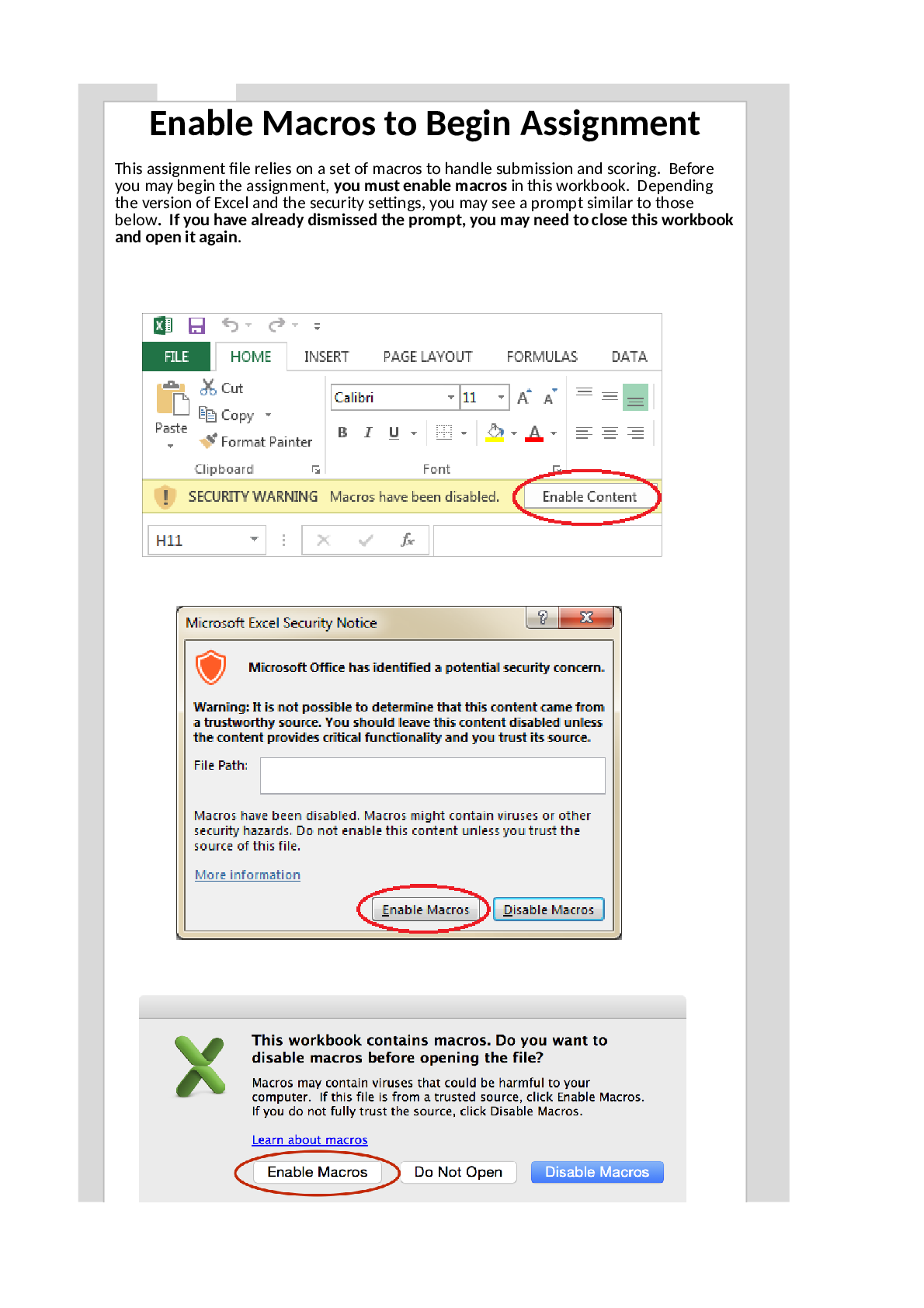


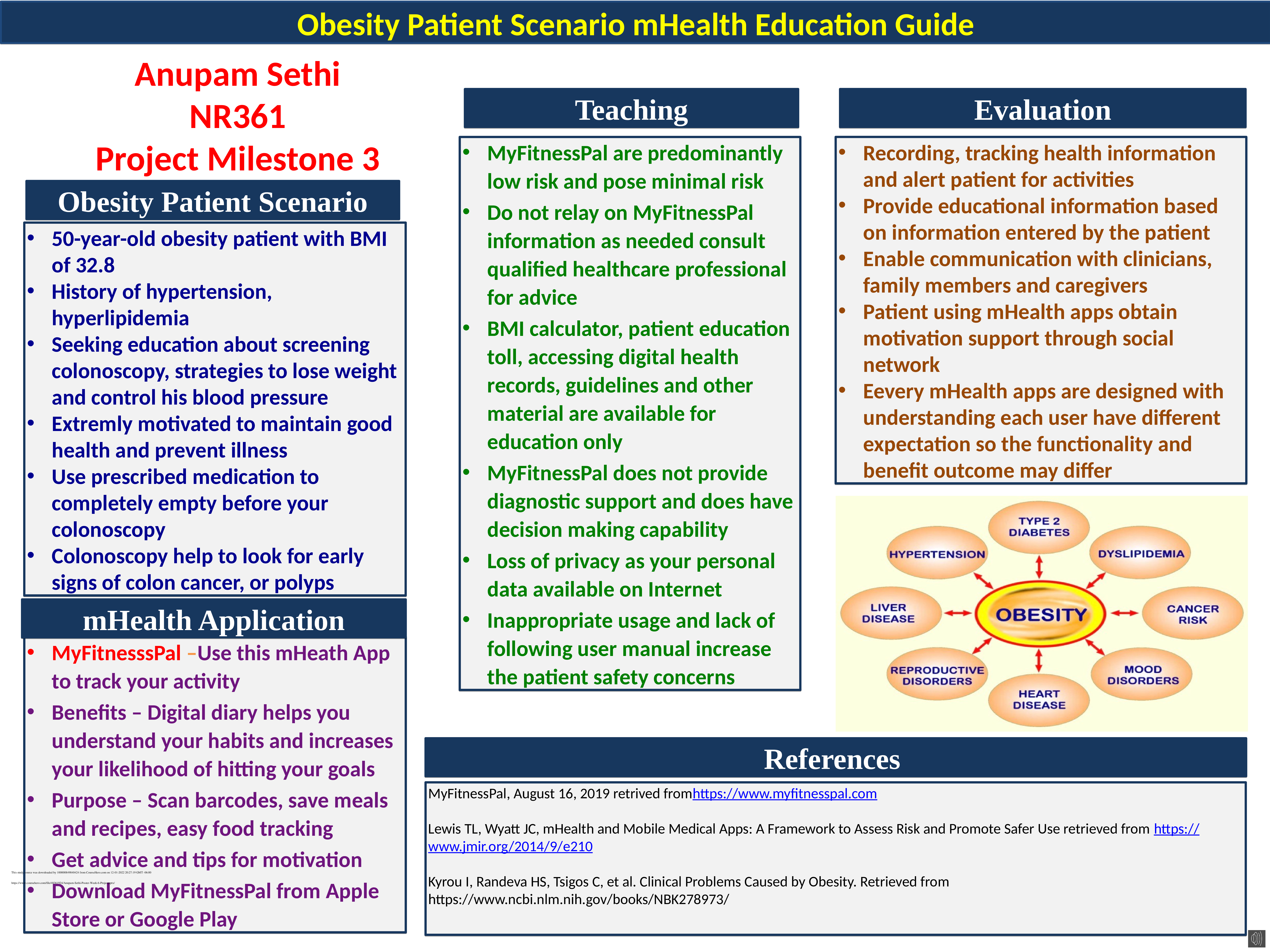

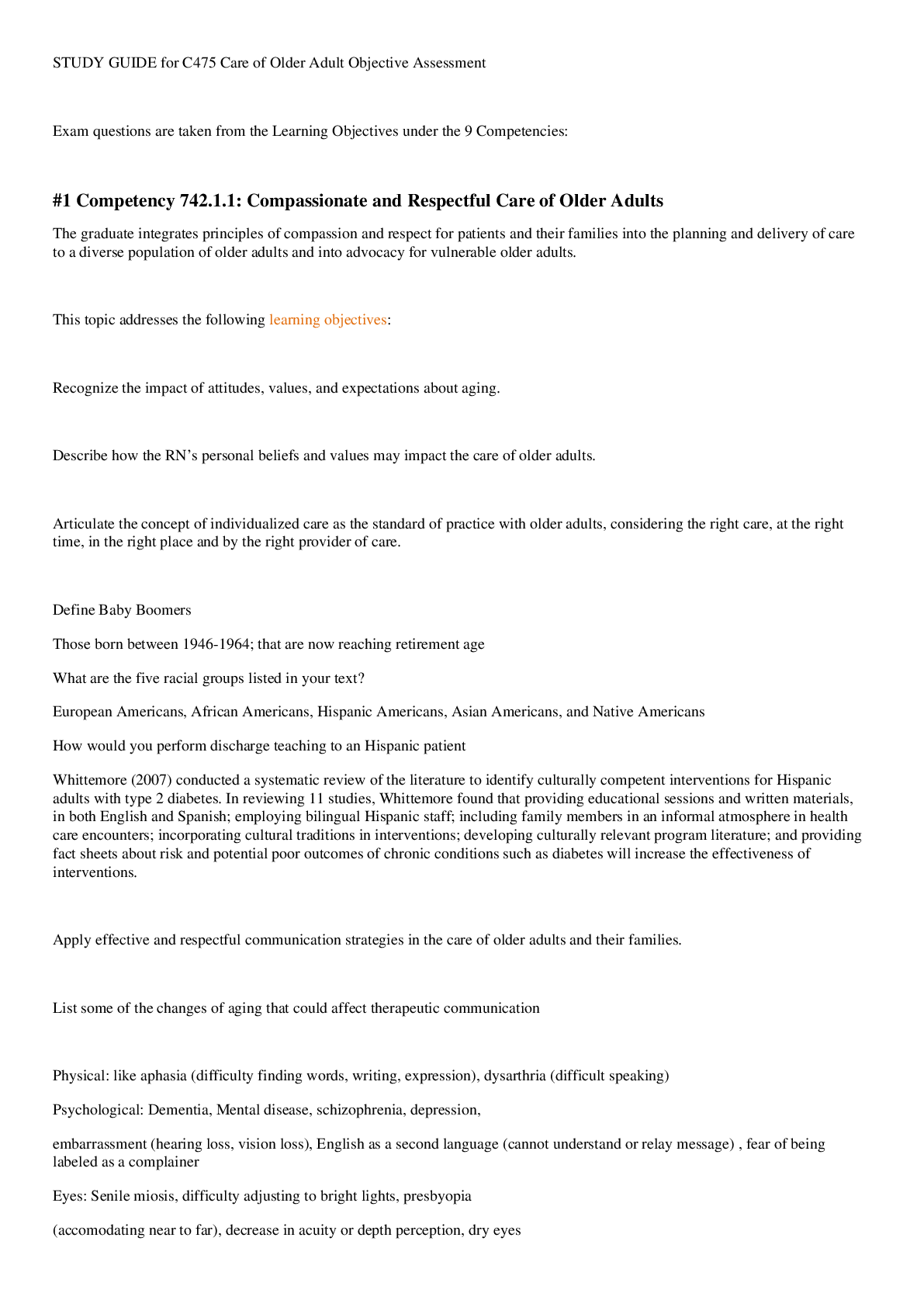
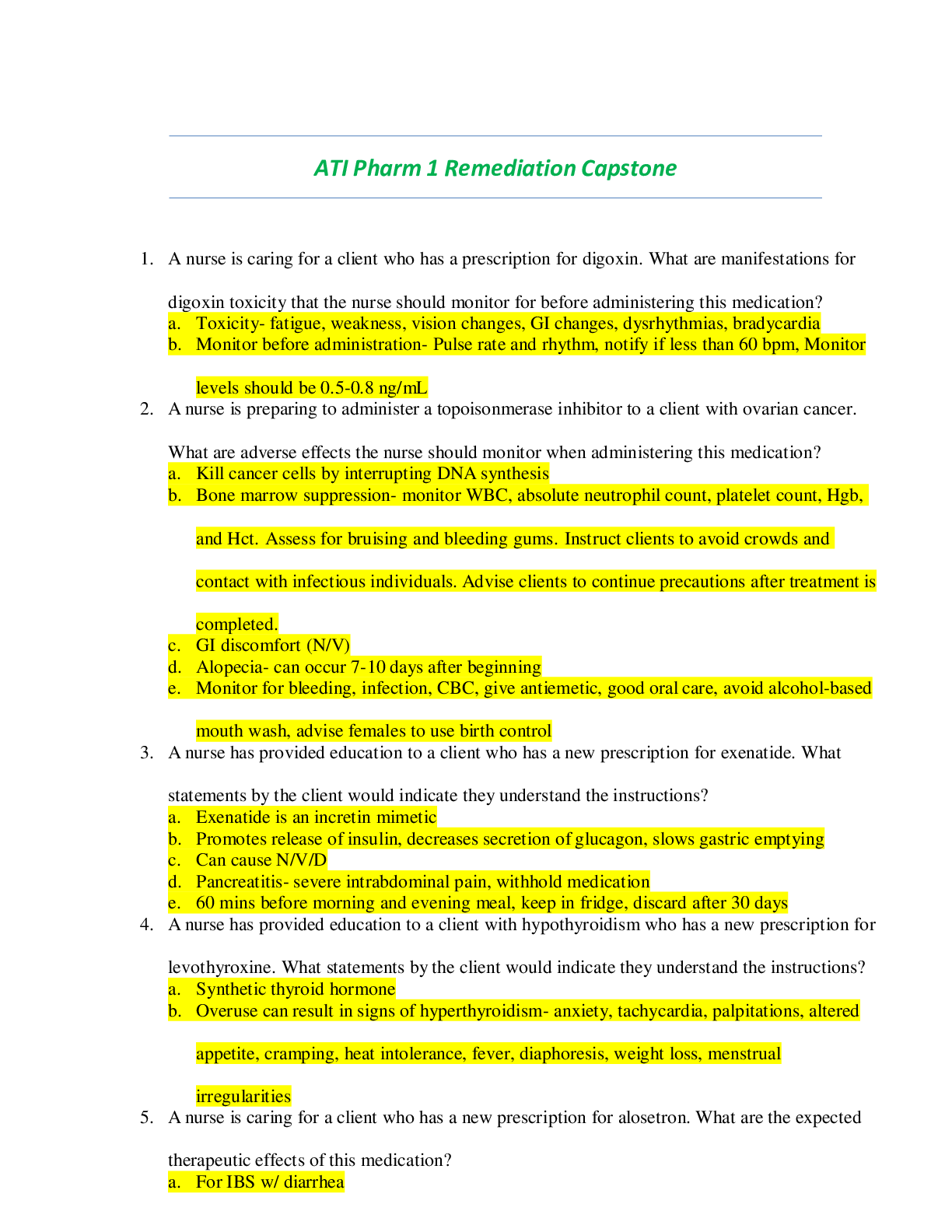
.png)


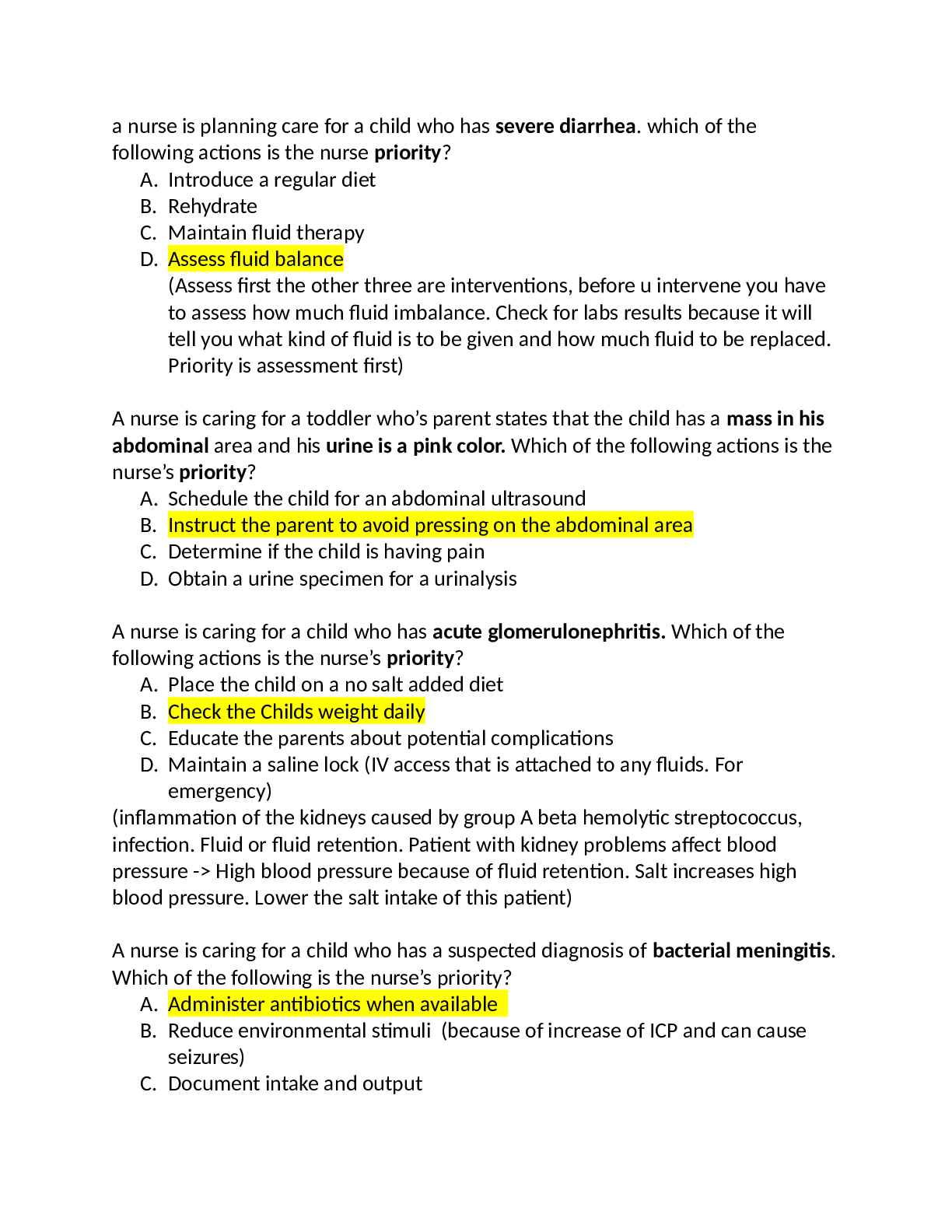

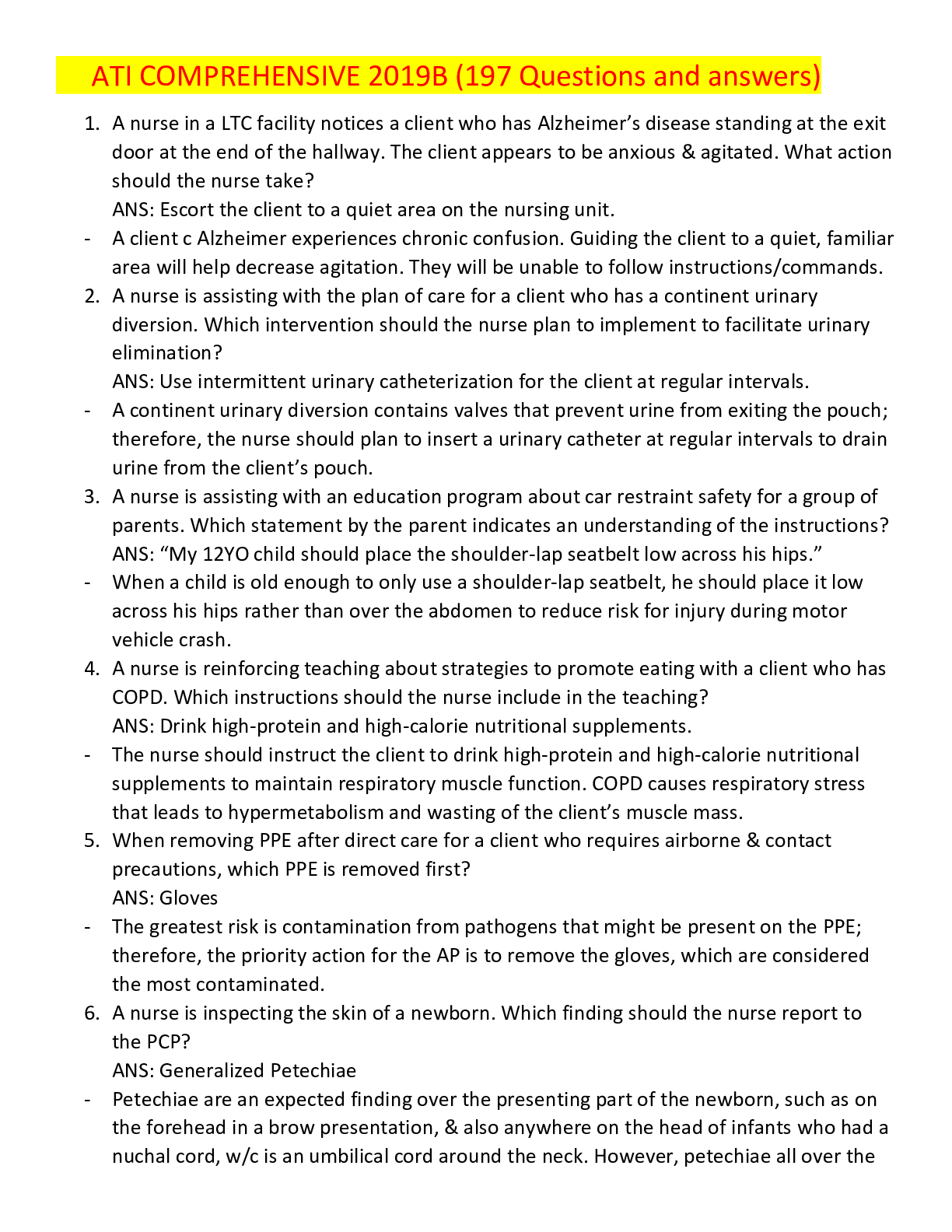

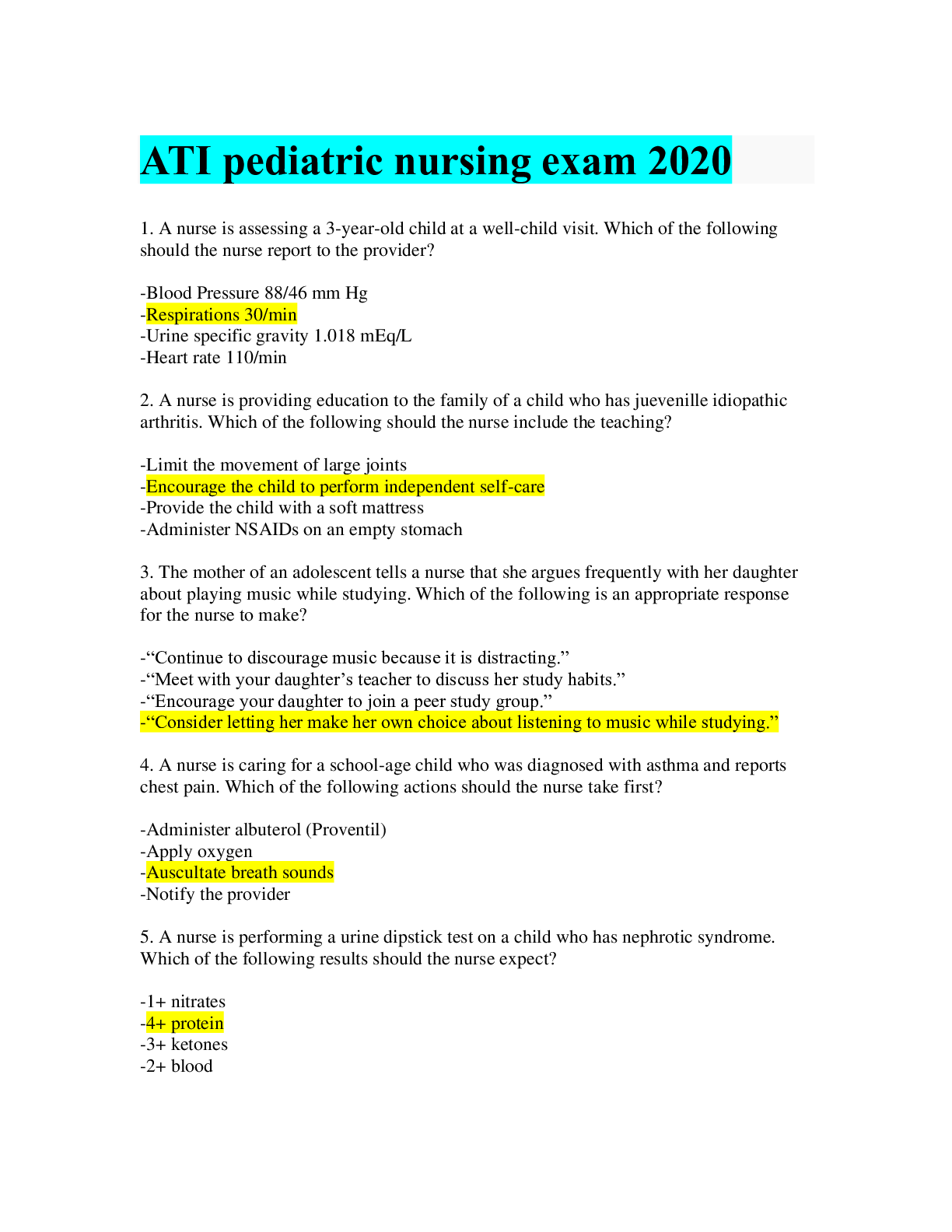



 – Miami Dade College.png)
Perop.png)


